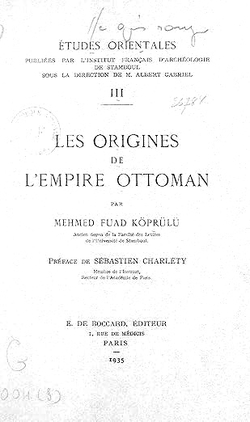 Initiating a custom in which, lamentably, other Ottomanists were to follow,[1] Mehmet Fuat Köprülü rather seriously erred in choosing the title for his study of Anatolia in the 13th and early 14th centuries, for this is not a study of the origins of the Ottoman empire. While an inappropriate title in no way reflects on the quality of the book's contents, it does severely affect one's view of its value. Thus, the reader who opens Köprülü's book expecting to find a contribution to the debate on the reasons why the Ottoman beylik developed into a universal empire will be disappointed; only seven pages discuss this topic. Were the book entitled something like "The Turks in Anatolia, 1200-1325," the reader seeking an interpretation of early Ottoman history would know to look elsewhere.
Initiating a custom in which, lamentably, other Ottomanists were to follow,[1] Mehmet Fuat Köprülü rather seriously erred in choosing the title for his study of Anatolia in the 13th and early 14th centuries, for this is not a study of the origins of the Ottoman empire. While an inappropriate title in no way reflects on the quality of the book's contents, it does severely affect one's view of its value. Thus, the reader who opens Köprülü's book expecting to find a contribution to the debate on the reasons why the Ottoman beylik developed into a universal empire will be disappointed; only seven pages discuss this topic. Were the book entitled something like "The Turks in Anatolia, 1200-1325," the reader seeking an interpretation of early Ottoman history would know to look elsewhere.
More unfortunate than the inappropriate title is the lack of unity of the book's contents. Les origines has the appearance of being a single work but, in fact, it is composed of several disconnected sections. In particular, the book's frame, its first and last sections, deal with general questions unrelated to the bulk of the book in between. One is left with the unsatisfactory sensation of having read masses of unanalyzed detail, followed by a few pages of unrelated and unsubstantiated theories. For example, Köprülü devotes one fifth of the book to an exposition of the various associations (military, religious, and corporate) in the beyliks and then makes no use of this information in his final analysis. But he ends the book (pp. 130-33) with theories based on previously unmentioned material, such as the rate of Ottoman expansion, the devolvement of sovereignty on a single ruler, the ease of Ottoman expansion in the Balkans, the Janissary corps, the effects of an hereditary aristocracy, and the characters of the first Ottoman sultans.
Rather than attempt to rework these elements into a unity, we would do better to break up the book into its unrelated parts. They number five:
a) a critical exposition of Herbert Gibbons' The Foundation of the Ottoman Empire (New York: Century, 1916), pp. 5-19;
b) a sketch of the sources and an explanation of methodology, pp. 19-32;
c) a political and social history of the Turks in Anatolia in the 13th and early 14th centuries, pp 33-123;
d) an extremely brief outline of early Ottoman history, pp. 124-26; and
e) a list of important factors in the Ottomans' rise to power, pp. 126-33.
With the component parts now separated, let us analyze them in turn.
a) Köprülü effectively and constructively refutes several of Gibbons' notions, such as his absurd idea of an "Ottoman race" (p. 10). But Köprülü maligns Gibbons when he claims that "his fundamental thesis appears extremely frail" (p. 7) and then never deals with that thesis. For Gibbons, the key to understanding the success of the Ottomans in establishing an empire was the crucial role of the European element in early Ottoman expansion. Instead, Köprülü challenges him on what Gibbons would consider to be far less important points, such as the religious affiliation of the earliest Turks in Anatolia and the historical value of Osman's dream (pp. 10-15). As with the book's title, this is another case of Köprülü' s sloppiness needlessly damaging the value of his work; for while he does successfully refute some of Gibbons' minor points, his challenge to Gibbons' fundamental thesis comes to nothing.
b) The sketch of the sources is once again a case of good work which suffers because of carelessness. In one short paragraph on page 22, Köprülü lists five major sources by title without naming a single author or noting any publication data. As Les origines is without a bibliography, this failure presents an obstacle to others interested in pursuing the subject.[2]
c) This section constitutes the bulk of the book and represents largely original research by Köprülü. He discusses here the general history of the Anatolian Turks from 1200 to 1325 and follows with a study of the march areas, placing a special emphasis on their social composition. Unfortunately, the author's lack of rigor mars this section too because he has almost completely failed to provide references to primary sources. Thus, for example, Köprülü describes the town of Sivas in the 13th century on pages 72-73 without any indication of his sources. Rather, he is content with providing a summary of "the information provided by all the sources that deal with this city in the 13th and 14th centuries."
d) The exceedingly short outline of Ottoman history from its earliest times to the year 1389 provides no more than a sketch of the well-known landmarks of Ottoman expansion. It is not related to the rest of the book and serves no useful function on its own.
e) While a list of factors which contributed to the rise of the Ottoman Empire is not an appropriate conclusion to the book, Köprülü does provide valuable suggestions in this section which might well stimulate further research.
 Mehmet Fuat Köprülü. |
Asia Minor was in a state of turmoil between the battle of Manzikert in 1071, which opened Anatolia to the Turks, and the definite emergence of the Ottoman state as the leading Turkish power in the area in 1387, as a result of their victory at the battle of Iconium in 1190. During these three centuries, the land was divided between the Byzantines, the Seljuks, and a sizeable number of beyliks of which the Ottomans were initially just one. For Köprülü, the Türkmans provide the key to understanding this period; large of numbers but in small groups they infiltrated Asia Minor, bringing with them both the Islamic religion and their own Central Asian culture, as well as a mixture of the two, that elusive quality known as the "ghazi spirit."
In an attempt to reach some kind of understanding of the Türkmans, Köprülü has been guided by two historiographical considerations: firstly, that the beyliks must be seen in the light of Seljuk history (pp. 29-30). This means emphasizing the Turkish, rather than the Byzantine, elements of their civilization, a badly needed corrective, for until recently, Ottomanists had consistently overemphasized the non-Turkish aspects of the empire.
Secondly, Köprülü believes that due to the difficulties in studying this period – its complexity, the scarcity of contemporary sources, the absence of modern studies – it is more useful to study the morphology and development of Turkish institutions than to establish the details of political and military narrative (pp. 30-31). Köprülü justifies this de-emphasis of events by pointing out that "the historian's aim is to explain the workings of a society" (p. 31) and to this end he has attempted to use the historical methodology developed in the 19th century to raise the level of medieval European studies.
Though admirable, this has proven to be a wholly infeasible project. Like so many other modern ideas, historical criticism developed naturally in Europe over centuries and is unsuitable for direct transposition into a non-European context. In this case, the problem lies in the dearth of facts. Countless historians over hundreds of years have contributed to studying medieval European history and building up a storehouse of facts; while the history of 13th century Turkish Anatolia was utterly obscure until 1968 when Claude Cahen published his Pre-Ottoman Turkey (New York: Taplinger, 1968). In other words, Köprülü has adopted methods which presume a solid knowledge of the facts of the period and, working without this knowledge, has postulated theories almost entirely unsubstantiated by the evidence.
An example: Köprülü supports the statement that "although the Muslims and Christians were adversaries on opposite sides of the Turkish-Byzantine frontier, there was no profound hostility between them" (p. 95) with only two references. The first is to the "Byzantine historians" describing these relations on the tiny islands of Lake Beyshehri; the second, to a study of the Digenis Akritas and Sayyid Battal epics which notes that they both reflect "similar conditions of life and that [the two peoples] lived in intimate and even amicable relations" (p. 96). Köprülü, then, is basing his judgement of a crucial aspect of march-land life on the evidence provided for a single locality and by poetry. This is inadequate documentation by any standard, and especially for a history which claims extensive use of sources. It should be noted further that Köprülü found both of these references in the secondary literature, and not in original sources.
This said, it is only fair to add that later research by Cahen, Ebru Turan, Spyros Vryonis, and Paul Wittek has largely confirmed Köprülü's theses about the origins of the Anatolian Turks, the social associations of pre-Ottoman Anatolia (such as the akhis), and the process of Islamization. One might say, therefore, that the lasting value of Les origines lies in the stimulus it gave to historical studies of the first three centuries of the Anatolian Turks. Köprülü noted the sources available, sketched the contours of the history, and presented his own astute interpretations of the social developments. Considering the difficulties inherent in the subject, he did remarkably well.
Finally, a few words about the historiographical context of Les origines: although the book appeared in French, the author was a Turk and this work was published at the height of the Turkish Republic's involvement in history, only five years after Atatürk founded the Türk Tarihi Kurumu (Turkish Historical Society). While Köprülü's approach hardly counters the spirit of the movement to glorify Turkish culture, he cannot be accused of having indulged in the wild. romanticism of so many of his colleagues. In fact, considering the historical circumstances in which it was written, Les origines emerges as an especially impressive book.
[1] Gibb and Bowen's Islamic Society and the West is a study of 18th-century Ottoman institutions, while N. Itzkowitz' Ottoman Empire and Islamic Tradition deals with the history of' the empire to 1683 and does not discuss Islamic tradition at all.
[2] In particular, note that Jawãmi' at-Tawãrīkh is referred to by title alone. This could be a reference to either the famous work by Rashīd ad-Dīn or to another book with the same title by at-Tanūkhi.